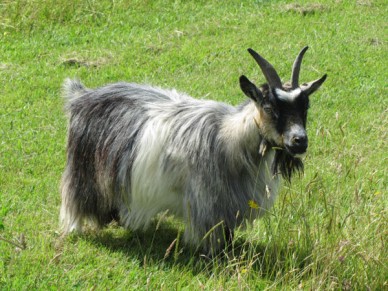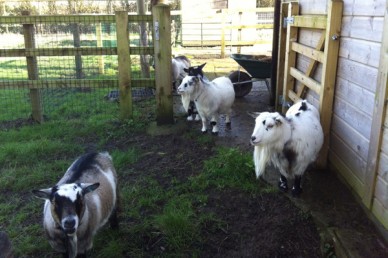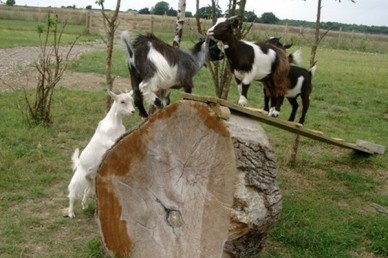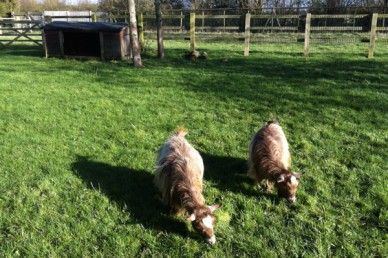Pygmy goats: an introduction

The breed of pygmy goat as we know it in this country owes its origin to the cross-breeding of two different types of miniature goat found in the equatorial regions of Africa – The West African Dwarf, with its disproportionately short legs, deep body and short neck, and the Nigerian Dwarf. The resultant variety is better proportioned and makes for an extremely endearing looking animal.
Both females and castrated males (wethers) make good pets but, unless you are an experienced keeper, owning at least half a dozen females, you should never buy an entire male as they can be very difficult, demonstrative and have some pretty unpleasant habits – such as peeing down their legs and beards to attract females. A responsible breeder wouldn’t sell entire males to a new keeper. Male goats should be castrated very young to avoid this undesirable behaviour developing as, once the male character traits have established, although they may diminish, they may not disappear completely.
You should always buy from a reputable breeder and preferably opt for animals registered with the Pygmy Goat Club as, although they are more expensive, this ensures the integrity of your goat’s background. However, this doesn’t mean that you won’t find very handsome unregistered animals and, in fact, The Pygmy Goat Club also has a Pet Record for goats who are not eligible for registration such as wethers and females with disqualifying faults.
You will be allowed to collect your goats at 12-14 weeks old.
Legal requirements
As goats are a cloven footed animal like cows and sheep every movement has to be traceable so you cannot move a goat onto your premises without first obtaining a holding number – this you can do through your local DEFRA office which will also give you a herd number. Even with all registrations completed you are not allowed to move your goat off your land without filling in an AML (Animal Movement Licence) – also obtainable from DEFRA – and returning it to your local Trading Standards Office. Pig movement forms have now been moved online but for goats they are still paper and something you will have to get used to if you are moving your goats regularly. The only occasion that you will be allowed to move your goat without a form is when taking it to the vet. Goats are also required to have two tags, or a tag and a tattoo, displaying the same number, one in each ear.
General characteristics
Never keep less than two pygmy goats, they are herd animals and as such thrive on company – it would be quite wrong to keep them in solitary conditions no matter how much time you can spend with them.
Both male and females have horns and, although pygmy goats are small, they can still deliver a painful butt or an accidental jab to you or their companions when excited. Because of this and especially if you have children, you may prefer to have these removed through a process called disbudding. This should be carried out by an experienced vet under a general anaesthetic as pygmy goats have thin skulls and probing too deep during the procedure can cause encephalitis. There is also the possibility of a small amount of regrowth called scurs but this often breaks off again and is rarely a problem. Disbudding is a matter of choice for individual keepers but, if you do decide in favour then it should be done early, at around 2 weeks old, meaning it will usually be carried out by the breeder. However, some breeders won’t disbud so it is worth checking this early on in the buying process.
Pygmy goats can be a little nervous around unfamiliar people and it can’t be stressed enough how important regular handling is. This should start from an early age and is the key to a easy life with your goats – so much so that a good breeder will have already started the human acclimatisation process for you. This is something you should carry on when you get them home especially early on when you should spend as much time as possible around them. If they do appear nervous a good way to get acquainted is to take a book into their shed for a read. As you remain calm, quiet and engaged they will become increasingly inquisitive and want to investigate further. A regular routine is also a good way to get them behaving predictably with food being the best enticement. Bringing them in at night for a feed before they settle in their shed will soon teach these clever little animals the bed time rules – much as you might bath, bottle, bed for a child.
Feeding
Good quality hay will make up the majority of their diet but this can be supplemented with fruit, vegetables and small amounts of proprietary pygmy goat mix.
The thing to remember here is ‘feed fit for purpose’ as animals at different stages of their lives may need slightly different feeding regimes. It is very important not to over feed hard food, especially with wethers, in order to avoid urinary calculi (kidney stones) which can be very painful or, in the worst cases, fatal. Too much hard food can also upset the balance in the rumen (the first of their four stomachs), causing a build-up of acid and consequently an accumulation of gas which they can’t get rid of and this can be very dangerous. Fully grown females will only need two, two ounce portions of hard food a day. Wethers should have even less at about one handful per day and kids should be fed only very small amounts according to what the breeder recommends. In winter dried grass or alfalfa mixed into the hay helps them generate heat internally and is especially good for ageing animals.
Pygmy goats are not grazers but do love to browse and will enjoy long grass, leaves, bark and the occasional weed if available in their enclosures. You must be careful to check what they have access to, though, as there is quite a long list of plants that will be poisonous to them including some very widespread varieties such as yew, laurel, oak and acorns, privet, rhododendron, honeysuckle, laburnum and flowers with bulbs such as tulips or daffodils – especially important if you are keeping them in a back garden. Although an occasional chopped up apple or pear is a great treat for them try not to let them have unlimited access to fallen fruit as it can ferment in their stomachs and, again, cause them to swell which can be very dangerous.
Contrary to popular belief goats can be fussy eaters and they do have individual likes and dislikes which you will discover as you try different things. Anything new should be introduced gradually. A tip here is that, although you might like to give them a treat occasionally, you should try to avoid hand feeding otherwise they can come to expect treats from you and should you not come up with the goods, they may try to encourage you with a butt. Remember, all treats in the bowl.
Health issues
Generally, the best way to keep on top of your animals health is observe them regularly, the more you do this the more you are likely to notice any uncharacteristic behaviour that could be an indication of something being wrong. Other than this, their droppings are a great indicator of health. They will usually be like rabbit droppings but loose or clumped stools can be an indication that the rumen is not working properly or their diet is incorrectly balanced. First thing to do if the droppings change consistency is to make sure the animals cannot eat anything other than hay, which will often cure the problem but be prepared to call out a vet as some conditions cause their health to deteriorate very quickly.
Your goats should be vaccinated for tetanus and Enterotoxaemia at 4 weeks if the doe has not been previously vaccinated, otherwise the first vaccination is given at about 8 weeks, and then repeated 4-6 weeks later – ideally by the breeder – with boosters every 6 months. Enterotoxaemia is a nasty condition also know as overeating disease that is triggered by a change in diet. There are two strains of bacteria that are normally dormant in the gasto-intestinal tract of a pygmy goat but an increase in the amount of grain, lush pasture or protein in the diet can cause rapid multiplication of this bacteria releasing toxins and causing diarrhoea. This can be fatal. Most vaccinations are only fully tested, and therefore licensed, for use on sheep. Pygmy goats don’t retain the benefits of these vaccines as long as sheep which is why boosters are given twice a year instead of annually as recommended on the labels. The vaccine recommended by the majority of vets, is Lambivac. Avoid using Heptovac and certainly do not use Heptovac P.
Any vaccinations that are administered to your animals will need to be recorded in your record book that should be kept with your herd book. This is blanket practice to protect the public from eating any animal that has been given medication so, although it is very unlikely that anyone would eat a pygmy goat, you still have to follow procedure.
Worming is necessary but it is now thought that over worming can lead to drug resistance so vets are recommending that routine is determined more by the size of the enclosure, herd size and the worm burden of the land which can be determined by testing a dung sample (Faecal Egg Sample – FEC). Kids bought from a reputable source should have already been treated at 6 weeks old and should then be wormed every six to eight weeks for the first year unless an FEC analysis indicates differently. If you are less sure of the animals’ background then it is best to worm immediately. If in doubt take advice from your vet. You should also keep your goats off their pasture for 24 hours after worming to prevent recontamination occurring.
Your goats will need their hooves trimmed every 4-6 weeks to stop the front of the hoof getting long, forcing them to walk on the back of the heel which can lead to other problems. Trimming is a fairly straightforward procedure which your vet or breeder should be able to demonstrate. Some people find that putting their goats on a table makes this easier – obviously be careful that they are protected from falling when doing this. They can also pick up lice but a dusting of louse powder in the spring and again in the autumn should keep infestations at bay.
Finally, you will also need to provide a yellow mineral block which helps regulate the goat’s salt and zinc levels and prevent certain skin conditions.
Housing and shelter
Pygmy goats’ coats aren’t waterproof like sheep so they do need shelter at all times, not just at night. They are fairly hardy and could be kept outside with suitable shelter and appropriate bedding for the weather conditions however, for safety reasons, it is always better to bring them in at night and it is essential for kids who are very susceptible to fox attack.

You should provide an all weather shelter in the paddock
A six-foot by eight-foot garden shed (below) will be perfectly adequate for two goats – a little modification to the entrance to create a stable door will allow you to ventilate the shed properly and the addition of an inner wire covered door will protect against predators. Straw or wood shavings can be used on the floor and a bench for them to jump up and sleep on is always a popular addition. Any windows should be perspex, not glass, to avoid the inevitable breakage as they climb up or butt windows.
In addition, you should incorporate an area of hardstanding adjacent to the shed as goats really don’t like wallowing about in the mud when the weather is particularly wet and will much prefer a concrete or paved area until it dries out a bit.
Fencing needs to be four feet high and ideally of solid post and rail construction with weldmesh covering the gaps. You can use other types of wire such as stock wire but young kids can escape through the larger holes unless you cover them with chicken wire until they are bigger. Chain link has a tendency to unravel especially if your goats have horns.

Sturdy post and rail fencing with weldmesh panels
As goats are naturally surefooted they do also like to climb and jump about which is something worth remembering when kitting out their paddock. They will appreciate some sort of climbing frame, a wooden pub bench makes a good viewpoint but affix a solid board over seats and table top to avoid little hooves getting caught in the gaps. Logs or platforms constructed from railway sleepers will also make good playthings, just remember your construction must be sturdy to avoid collapse under their weight.
Pygmy goats can live for up to 15 years and are, as with any animal, a commitment but if you can provide the right environment and can commit enough time to them they do make lovely pets. They are intelligent and affectionate with characteristics that could almost be compared to dogs – even sitting on your lap given the opportunity. If you do get to the point where your females have bred then you can even get milk from them although, unless you are very dedicated, there are much easier ways of getting your daily dose of calcium.
For more information visit the Pygmy Goat Club website. Membership entitles you to a magazine containing useful articles and the invaluable services of an area advisor. It also allows you to officially register your goats. There is also the recently reopened chat group which is available to members and non-members alike and is a great source of advice.
6 Comments
Leave a reply
Livestock categories
Most recent Livestock articles
- How to Maintain Your Paddock 09th September, 2017
- Absolute beginner’s guide to breeding sheep 05th November, 2016
- Absolute beginner’s guide to keeping sheep 02nd October, 2016
- Beginning back garden beekeeping 06th September, 2016
- Mini Moos: The world’s most popular beef cattle ‘repackaged’ for smallholders 24th August, 2015
- Iron Age Pigs: this boar is no bore 04th August, 2015











I have to say that for the last few of hours i have been hooked by the amazing posts on this website. Keep up the great work.
Many thanks for your comment Sherice. We try to provide both interesting and informative content – glad you are enjoying the site. Remember if there is ever anything you would like to read about that isn’t already covered we are always happy for suggestions.
I need some advice i have been given two male goats father & son ages 2 & 8months i was told They are friendly, this is not the case & the father tries to mate his son, at the moment They are tetherd 3m cord unable to reach one another
Advice would be appreciated
Hello. I have a 1 yr old male pygmy and a 1.5 yr old pygmy/nigerian mix. My male has started, the last month,turning to the side and his penis is showing. He has been castrated. It’s almost like he is trying to show it to me. Mind you, this goat is my little guy and is a bit spoiled, if he has an itch he will show me where it is so I can scratch it for him. Did I mention I had to bottle feed him?
I think my female is going into heat. She actually has developed an udder this week which is odd as its physically impossible to be pregnant. So those are my 2 situations. Have you ever heard of either?
is it okay to run an 1 year old female pygmy goat with an 6 year old male..
If the poor old devil can cope with it I’m sure it’ll be fine :0)